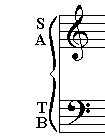
Part
- A part in music is very much analogous to a part in a play
- In a play, one person plays one part throughout
- The part may not be on stage all the time
- The part may be on stage at different times, with different
other parts
- A musical part normally consists of all the
notes (and
rests) on a single
stave which is intended for a single
type of instrument or voice.
- It is common for many individuals to be playing or singing the
same part, for example the three clarinets in an orchestra, all
the basses in a choir, or the two female singers in a folk band,
so they will all be reading the same line on similar copies.
- However, it is also quite common for more than one part to be
written on one
stave.
- Two is common (e.g. soprano and alto in a choir, first and second
oboes in an orchestra, bass drum and snare drum in a drum part),
three or more is very rare, simply because it gets too confusing.
- When there are two parts sharing the same stave, one part is
written with the stems
of the notes pointing
upwards, and the other with the
stems pointing downwards. The part
which is generally higher in
pitch and therefore higher on the
stave (e.g. first oboe, soprano) has
the stems upwards, the lower one has
the stems downwards:

- There are two problems with this:
- It can look confusing when the parts cross over (i.e.
the lower part goes above the upper part), but each part
still keeps its tails going in the same direction (see
the end of the first bar in the the example below),
so it is clear which part is which. This is probably the main
reason why it is important for the
stems of
notes to be drawn on the
correct side.
- Some types of note, depending on their
note lengths, may not have
stems, so it is then not
possible to differentiate which note is intended for which
part, except by assuming that the top note is played by the top
part. If there is any confusion, a straight line is usually
drawn between notes of the same part:

When there are several parts in a piece of music, they can be
written in two ways, "open score" or "short score".

- "Open Score" is when each part is written on a separate
stave (see example on the right).
Braces are used at the left-hand end of the set of
staves which are to be played
and heard simultaneously.
This set of staves is sometimes called a "line of music"
or sometimes a "system".
A choir or orchestra can then be asked to look
at the third bar on the second line/system on page 2,
and they will all be looking at the same place, but at
different staves within the line/system.
- "Short Score" is when there is more than one part per stave.
A choir of four parts can usually sing from two staves,
with two parts per stave (see example below).

In short score, the
stems of the
soprano and tenor parts go upwards,
the stems of the alto and bass parts go downwards.
- Even in Open Score, you can have two parts written on one stave,
for example, two soprano parts on the top line of the Open Score
example (above right).
- Open Score is usually easier to read for the individuals playing or
singing. Short Score is easier for a rehearsal pianist or accompanist
who needs to be able to play all the parts at once (although some pianists
are very good at reading four parts from Open Score!).
Mail me
Copyright and disclaimer
Content and structure of these pages
Return to top




